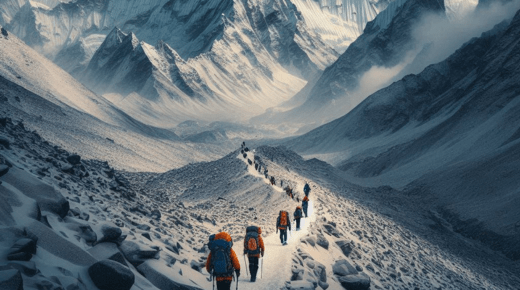The Everest Three High Passes trek is a lifetime challenging trek that demands trekkers physically as well as mentally, featuring possibly the best scenery anywhere on the globe. One of the biggest assets you can have to ensure you can complete this challenging route is the knowledge of Sherpas. This can include hiring professional mountaineers and local guides, as they have in-depth knowledge of the topography, and culture and achieve a challenge that not everyone who sets off to summit the mountain can achieve, a trekking event great, and epic in nature.
Sherpas are indigenous to the Himalayas and their expertise, built up over thousands of years of living and working in the Everest region, sets them apart. Their experience means trekkers will navigate the rugged — and at times treacherous — paths through Renjo La, Cho La, and Kongma La passes, each at an elevation of more than 5,000 meters. Sherpas possess an intuitive skill set, whether it’s mentoring you over rugged terrain or snowy inclines, they know how to read the mountains and adjust the route according to weather, infrastructure, and risk, ensuring the safety of their entire group.
In addition to their technical proficiency, Sherpas offer crucial assistance in altitude sickness. But trekking at great heights is tiring, and it is important for the body to acclimatize in order to avoid health problems related to altitude. Sherpas are well aware of altitude sickness symptoms and can make immediate decisions about adjusting the pace of the trek or, if need be, helping with emergency evacuations. They know that their experience, knowing what to expect along the way, and awareness of potential hazards, are the keys to keeping everyone safe and happy throughout the voyage.
And too, Sherpas are incredible motivators. The trek can feel a bit oppressive at times, but the Sherpas’ positive attitudes encourage and depth of knowledge about local traditions and history to create deeper roots with the land. Set off with Sherpas who help foster a sense of camaraderie, making this not just a physical challenge but a transformational journey through stunning villages, frozen lakes, and snow-covered mountains on the Everest Three High Passes trek. Their experience and guidance enable this once-in-a-lifetime journey to be safe, fruitful, and life-changing.
Introduction to the Everest Three High Passes trek
The Everest Three Pass Trek map is an unforgettable trek through the heart of the Everest region, with the reward of crossing not one, not two but three high passes. This trek is meant for experienced hikers who are looking for a tougher alternative to the Everest Base Camp trek. The trek crosses three of the highest and most formidable passes in the Himalayas, Kongma La, Cho La, and Renjo La. These mountain passes, which are located at higher altitudes over 5,000 meters, give scenic views where one can see the whole of the Everest region, the peaks like Mt. Everest, Lhotse, and Makalu. In addition to the incredible mountain scenery, trekkers walk through traditional Sherpa villages, Buddhist monasteries, and pristine glacial lakes. This trek is strenuous and it takes a lot of mental and physical preparation, on a day-to-day basis you will trek through very remote and high-altitude terrain over long days. Focus on the more off-the-beaten-path trails in the Khumbu region that remain a relatively calm alternative to the busy hiking route to Everest Base Camp.
The part played by Sherpas in high-altitude journeys
Everest Three Pass Trek package On high-altitude treks such as the Everest Three High Passes Trek, the Sherpas are an indispensable part of the experience, providing expert service and support that are vital to the success and safety of the trek. Being natives of the Khumbu region, Sherpas have an intimate knowledge of the mountains, terrain, and local weather patterns. They can survive at higher altitudes where oxygen is substantially less, making them a great help for trekkers who may be affected by the challenging conditions. Sherpas act as guides and porters, leading trekkers along arduous routes, ensuring that they remain on the correct path, and assisting them in traversing treacherous mountain terrain. They also help maintain the safety of trekkers by watching for symptoms of altitude sickness, providing advice for acclimatization, and administering first aid when needed. Sherpas help carry heavy loads too, so trekkers can concentrate on the journey itself. Their local knowledge also includes cultural insights, offering context on the region’s history, traditions, and spiritual practices along the way. Their entrenched knowledge of the land and capability in high-altitude trekking are essential to any Everest expedition.
Getting Fit and Packing for the Trek
To get you through the strenuous conditions and high-altitude environment of the Everest Three High Passes Trek, you will need to prepare beforehand with proper physical training and equipment. As the trek requires a mix of steep ascent, rocky terrain, and days of walking long hours in a row, it’s essential for trekkers to develop strength in their cardiovascular system through exercise (hiking, running, cycling, swimming, etc.). Strength training, specifically for the legs, core, and upper body, will be beneficial for carrying a backpack and navigating steep ascents and descents. Moreover, hikers should get used to the altitude by spending time at higher elevations, if able, before setting out on the trek. It is also important to mentally prepare yourself for the trek as it is physically demanding and quite tiring mentally and physically. When it comes to gear, trekkers must suit up for the extremes. The basic gear consists of warm layers (thermal clothes, down jackets, and moisture-wicking garments), durable trekking boots, trekking poles, and a well-made backpack. A sleeping bag rated for sub-zero temperatures, a headlamp, and a first-aid kit are also necessary since the trek will take trekkers through remote areas with unpredictable weather. Trekking in such conditions elevates the importance of wearing the right kit to be safe, warm, and comfortable meaning preparation is often the difference between success and failure on the trek.
An Overview Of The Three High Passes
Everest Base Camp Three Pass Trek Kongma La, Cho La, and Renjo La are the three high passes of the Everest region, which are a part of the Everest Three High Passes Trek with stunning experiences. Each pass is above 5,000 meters and has its own physical challenges, including steep inclines, rocky routes, and changing weather. At 5,535 meters, Kongma La, the highest of the three, is rocky terrain that affords breathtaking views of both Mount Everest and Lhotse, and Makalu. At 5,420 meters, Cho La is covered in snow, making it one of the more dangerous passes, requiring cautious maneuvering. Renjo La, the last pass at 5,360 meters, is less popular and features gorgeous views of the Everest region, including a glimpse of the wonderful Gokyo Lakes below. Not only is the journey between these passes physically demanding but it also allows you to witness a variety of surroundings, from secluded Sherpa settlements to untouched glacial waters. Trekking these high-altitude passes, trekkers will also witness stunning vistas of snow-capped peaks, making it a once-in-a-decade experience for those wanting to test their physical limits and explore the lesser-worn paths of the Everest region.
Beginnings: Lukla to Everest Base Camp
The trek to Everest Three High Passes starts with a flight from Kathmandu to Lukla, a small town at the entrance to the Everest area. The town of Lukla, at 2,860 meters, is one of the most adrenaline-fueled and risky airport landings in the world, outlined by steep mountain slopes. When trekkers arrive in Lukla, they start their hike going downhill, toward the Phakding Valley, and head in the direction of Namche Bazaar, the busy center of the Khumbu region. This village is an important acclimatization stop and is home to colorful markets, restaurants, and Sherpa culture. The journey from Namche Bazaar sees trekkers following the classic Everest Base Camp trail, along the way passing through picturesque villages, such as Tengboche, Dingboche and Lobuche, each presenting panoramic views of the surrounding peaks. The trail slowly ascends giving trekkers the opportunity to acclimatize before other high passes. As trekkers go along this path, they will also see the spiritual importance of the area, with bibulous landmarks marking off monasteries and stupas. Once at Everest Base Camp, trekkers can spend some time absorbing the views of the Khumbu Icefall and the foot of the world’s tallest peak itself before carrying on to scale the three high passes that make this such a tough and fulfilling adventure.
Inspiration: Crossing Kongma La Pass with Sherpa’s guidance
Everest Base Camp Three Pass Trek itinerary Kongma La Pass, which is at a height of 5,535 meters is the highest but also one of the toughest passes of the Everest Three High Passes Trek. Trek to Kongma La starts from Lobuche village a rocky steep climb for trekkers. Kongma La is the toughest because of its rocky trails and high altitude. In this part, you need the help and support of a Sherpa guide, as Sherpas are knowledgeable and familiar with the route, and they can help you navigate the rocky paths safely. They are trained to identify possible dangers and assist hikers in navigating the challenging climb. Atop Kongma La, trekkers are rewarded with expansive views of Mount Everest, as well as Lhotse, Makalu, and other giants of the Himalayas₇, and experience the grandeur of the Everest region from one of its highest points. The climb back down is equally challenging; it can be steep and rocky, requiring the utmost attention. Guided by a Sherpa, trekkers are able to traverse both the up and down portions of Kongma La, allowing them to access the massive views available from the pass while reducing the risk commonly faced during high-altitude treks.
Tips from Sherpas on Navigating the Cho La Pass
Cho La Pass is considered one of the hard and thrilling parts of the Everest Three High Passes trek. Located at 5,420 meters (17,782 feet), this pass connects the Gokyo Valley to the Khumbu Valley and offers trekkers a challenging, rugged trail, often covered with snow and ice. Crossing this pass takes immense physical strength, along with intimate knowledge of the land and mountain that only Sherpas possess.
Sherpas excels at reading trail conditions and adapting pace to the weather and terrain. Because they know the pass well, they can navigate trekkers past potential hazards like unsteady rocks or deep snow. One piece of advice Sherpas gives about traversing Cho La is to do so as early in the morning as possible to beat the afternoon storms and allow enough time to safely descend before dark. With steep inclines and unpredictable weather, having Sherpas at your side offers a sense of security and guidance.
Everest Base Camp Three Pass Trek cost Apart from giving good technical guidance, Sherpas are trained to know if trekkers are suffering from tiredness or altitude problems. They can suggest times for breaks and provide pep talks to keep morale up. By following their timing and recommendations, trekkers can cross Cho La with peace of mind, safe in the knowledge they’re in experienced hands. The attention to detail and vigilance of the Sherpas contribute to a smooth, successful crossing of this challenging pass.
Sherpa’s Expertise on Renjo La Pass
The Everest Three High Passes trek also includes Renjo La Pass (5,360 meters or 17,590 feet) as another highlight of this trek. It affords trekkers unbelievably stunning views of the Everest region, but it is a rugged section of the route with steep climbs and the potential for snow or ice. Renjo La trekking is not only a physically demanding outdoor business but also an exercise in local expert knowledge — where the Sherpa clan shines.
Sherpas are familiar with the conditions at Renjo La and give essential advice to trekkers before and during the climb. They advise acclimatization breaks and track weather conditions to keep trekkers out of danger during the ascent. Their advice is valuable for trekkers traversing precarious portions of the trail, where slipping is a genuine danger. Sherpas are also trained to look for signs of fatigue or altitude sickness and use it to adjust the pace to avoid issues.
Traveling over Renjo La with Sherpas means trekkers can enjoy the scenery while knowing they have the skills to safely pass this high-altitude pass. A Sherpa’s expertise under these conditions not only guarantees success on the trek but also helps make the experience more enjoyable. They know how to read the weather, the terrain, and your own limitations, to make sure every step is purposeful and considered. Renjo La becomes a challenging yet rewarding experience thanks to their encouragement and local knowledge.
The Role of Acclimatization and Assistance from Sherpas
Acclimatization is the most significant part of the Everest Three High Passes trek journey to be able to complete it safely. As climbers climb above 5,000 meters, the body needs to slowly acclimatize to the lower oxygen present in the atmosphere. Paste your text here… Only trekkers who properly acclimatize remain on course, as altitude sickness can curtail the adventure in a matter of days. This is where Sherpas come in, and their support becomes vital.
Everest Base Camp Three Pass Trek price Sherpas have an unparalleled knowledge of how to manage acclimatization schedules because they spend their lives in high-altitude conditions. They are intimately familiar with the symptoms of altitude sickness and can help trekkers detect early signs before they escalate to a more serious level. Sherpas know that a slow ascent is essential, which is why they will make sure that trekkers take a number of rest days to allow the body to acclimatize itself. They are also versed in recommending the “climb high, sleep low” technique in which trekkers go to a high point during the day and sleep at a lower elevation, to support the body’s acclimatization process.
Beyond their technical expertise, Sherpas provide a mental lift during the arduous acclimatization process. Trekkers to high altitudes can often face mental fatigue, but Sherpa offers encouragement, aiding trekkers to stay focused and positive during the process. Their familiarity with the area, along with their ability to gauge trekkers’ requirements and limitations, means they handle acclimatization correctly, making for a safe and rewarding trip.
Sherpa Support to Overcome Hurdles
Regarded as one of the toughest treks on Earth, the Everest Three High Passes trek is as rewarding as it is unpredictable. Navigating the rugged terrain, extreme weather elements, and high altitudes can be a challenge on its own. This is precisely where Sherpas come into play, helping alleviate some of these struggles with their knowledge, assistance, and direction along the way.
Sherpas are skilled at reading when trekkers are experiencing physical stress or mental exhaustion. They monitor the conditions on the trail, recommending when to stop for breaks, how much to drink, and how fast to go to ensure trekkers are not pushing themselves too hard. Indeed, Sherpas not only help handle physical challenges, but they also play a vital psychological role in helping trekkers deal with the psychological blocks they come up against. Whether helping with morale during an arduous section or offering mental toughness when things get tough, Sherpas are always there to assist.
One of the toughest questions on the Three High Passes hike is coping with the consequences of altitude sickness. Sherpas are uniquely adept at noticing the early stages of altitude sickness and can immediately slow the pace suggest rest periods or even insist on descending to a lower altitude. Whether exposed to the elements or battling fatigue, trekkers remain safe and well-supported every step of the way—thanks to the mountain experts who beckon them forth.
Sherpa guided safety and emergency protocols
The Everest Three High Passes is a high-altitude, remote trek, and safety is always the most important factor: Sherpas are trained and experienced to respond in the event of an emergency. Though an epic adventure with stunning beauty, the high altitudes, difficult terrain, and changing weather make expert guidance a must for the trek. Sherpas are trained to respond to a wide array of potential emergencies, from altitude sickness to injury or abrupt shifts in weather conditions.
They are very experienced and experienced in first aid and understand the hazards of high-altitude trekking. They are trained to notice the early symptoms of altitude sickness — dizziness, nausea, or headaches — and are able to intervene swiftly before the condition becomes more serious. If emergency medical treatment or helicopter evacuation is needed, Sherpas are also trained to administer immediate medical assistance and help coordinate your evacuation to a lower altitude or to get to a helicopter. Read more About Gimkit Join
Besides their medical skills, Sherpas are familiar with the safety measures in the area. They’re trained to deal with sudden rain storms, temperature extremes, or any other environmental factors that can put trekkers at risk. Whether they are showing trekkers the ropes of staying hydrated, packing the proper gear, or knowing when to turn back in the face of treacherous terrain, Sherpas are there to guide trekkers each step of the way to ensure their safety.
Next: How a Sherpa Can Elevate the Experience for You
The Everest Three High Passes trek is a remarkable going to the place that is known for its rich landscapes, and grand valleys intertwining through strong mountains. The journey’s success then lies in the expertise of the Sherpas who guide trekkers through this treacherous terrain, although preparation and willpower play a big part. Their expertise with the mountains, the weather, and the culture elevates every element of the trip, transforming a difficult journey into an extraordinary experience.
Everest Base Camp Three Pass Trek map Trekkers are provided guides, but it is these Sherpas who really hold the trek together, guiding trekkers from mountain to mountain, ensuring they are safe, at an optimal acclimatization level, and psychologically ready to take on the next challenge. Whether it’s giving advice on avoiding the high passes or just emotional support in the hard times, Sherpas make the trip not only doable but also fun. Their training in altitude sickness management, emergency response, and encouragement through the most challenging stretches of the trail make them invaluable partners on this epic journey.
With that, yak herding, and summits of peaks to the East of the pass behind your mind, trekking with Sherpas offers you the opportunity to experience the Everest Three High Passes in a safe and enriching way. Their presence also guarantees your safety and helps you feel much more connected to how the history culture and beauty of the region. The experience takes you hiking not just with a Sherpa, but creating an immersive experience to your liking that you are sure to have memories for the rest of your life.




